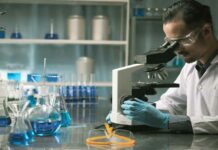Antimicrobial Resistance- AMR as it is referred to, is rising, and an AMR review that was commissioned by the UK Government has gone on to predict that by 2050, an additional 10 million people may as well succumb to drug-resistant infections every year. The development when it comes to new antibiotics those that can be used as a last resort when other drugs happen to be ineffective happens to be a crucial area of study when it comes to healthcare researchers across the world.
A new synthetic antibiotic, which happens to be developed by University of Liverpool researchers, has gone on to show more effectiveness than the established drugs against superbugs like MRSA. The new study, which was published in in the European Journal of Medicinal Chemistry, goes on to demonstrate the potent activity of the antibiotic teixobactin against the bacterial biofilms. Biofilms happen to be clusters of bacteria that get attached to a surface and/or to each other, which happen to be associated with certain critical chronic infections in humans.
This work is constructed with pioneering research by Dr. Ishwar Singh, from the University of Liverpool, an expert in antimicrobial drug discovery as well as development and medicinal chemistry. A team of researchers which had been led by Dr. Singh went on to create simplified synthetic versions when it comes to natural molecule teixobactin, which gets used by producer bacteria in order to kill other bacteria within the soil. They have gone on to test a unique library of synthetic versions of the antibiotic that’s indeed game-changing, thereby optimizing major traits of the drug so as to enhance its efficacy and safety teamed with enabling it to be produced inexpensively at scale.
For the latest study, the researchers went on to design and also synthesised highly potent teixobactin analogues; however, they swapped out the major bottleneck building block L-allo-enduracididine with the commercially and low-cost simplified building blocks available, like non-proteogenic amino acids. Due to this, the analogues are now pretty impactful against a broad range of bacterial pathogens that are resistant, including bacterial isolates from patients as well as bacterial biofilms. This happens to be yet another pivotal measure when it comes to adapting the natural teixobactin molecule so as to make it apt for human use.
According to Dr. Ishwar Singh, Teixobactin molecules happen to be having the capacity to offer new treatment choices against multidrug-resistant bacterial as well as biofilm-related infections to enhance and save lives across the world. He adds that their study goes on to offer quite a promising base for further research and also brings about avenues so as to discover the application of teixobactin across numerous health-related biofilm contexts such as surgical site infections, implant-related surgeries, as well as cystic fibrosis patients.
It is well to be noted that this work that has been done happens to be funded by Innovate UK, the Rosetrees Trust, as well as the Department of Health and Social Care. Besides the University of Liverpool team, it also involves Singapore Eye Research Institute researchers, Nanyang Technological University from Singapore, the University of Utrecht from the Netherlands, the University of Lincoln from the UK, and the University of Ghent, Belgium.




















